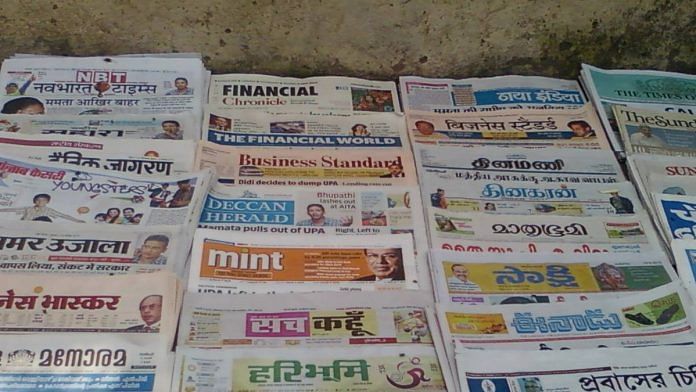
There used to be something about newspapers that made just ‘news’ into ‘News’.
Compared to the churning, seething mass of offerings, announcements, positions and
statements bubbling on the Internet, what was there in newspapers stayed still for long
enough to be read, and read again if you wanted. When you finished, you could use the
paper to line drawers, collect vegetable parings, or clean window panes. Not just that,
hell you could even sell the stuff.
On a recent morning, like many others, I thought I would look at the newspaper to find
out what it had to say on the Indian FM’s visit to the US, the war in Ukraine, the Imran
Khan fiasco and other happenings. You know, what old-timers like me still call ‘news’.
I picked up the thick bundle that the newspaper-wallah had left outside my door and
pulled out what seemed to be the 'main' paper, ignoring the colourful large and small inserts that fluttered out. Page 1: full page glossy advertisement for a grocery supplier who promises to deliver vegetables as soon as you think of them. Page 2: likewise, with more details. Page 3: full page ad from a competing grocery supplier whose vegetables reach before you even think of them. Page 4: more details. Then a vertical half-page with ads on both sides; is that Page 5.5 or Page 6? The next page is wider than the
others so a flap sticks out like a frill when the paper is folded; the corresponding page
that appears later is narrower but who cares? That one just carries news.
Finally, some real news on Page 8 or thereabouts (depending on how you count), but
only on the top half of the page; an ad for a new mobile phone screams at you from the
lower half. Page 9 has a few bits of news scattered about and Page 10 a little more
news in a vertical half page with ads on the other vertical half.
I began to wonder at the futility of it all and turned to the back hoping to find the sports
page: Did PV Sindhu win? Have Mumbai Indians lost again? How did India’s Junior
Women’s cricket team fare? Instead, I was greeted with a full page of unlikely images of
buildings set against a starry night, where I could hope to live with the cream of the city.
Right at the bottom was a tiny disclaimer, when I found it, to say it was an artist's
impression of something that is still in the developer’s mind.
The style of newspaper advertisements has changed a lot. At one time, The Times in
London used to just have only classified ads on the front page. Looked at closely
though, this wall of seemingly stiff-lipped offerings had chinks: there was often one from
‘Nurse SRN’ who provided ‘colonic irrigation in discreet clinic’, and others like it to satisfy
those in need of quiet prurience.
The New York Times set its own standard with a Sunday edition that weighed around 1-
2kg and had enough in it to read through the week. Advertisements in the popular US
newspapers could be more grabbing. There might be an image of an aggressive young
man in a shiny tight suit shouting ‘Want a suit?’ and following it with ‘Take two!’ next to a
picture of an overwhelmed customer having suits flung at him. In contrast, air-brushed
close-ups of women with flawless make-up and every hair in place would taunt the
domesticated looks we all live with and offer a path to a cosmetic-aided perfection.
The Internet has been the great leveller and companies across the world vie to get
eyeballs (and fingers) on their web-pages.
Newspaper ads are just one of the channelsfor this so they must tempt you with extravagant offerings to click on their links. Once they have you captive in their advertising hyperspace, they bring out all their selling blandishments to make you buy what you may not even have thought about. Instead of being mere objects of paper and ink, ends in themselves, newspapers have become pathways to the glossy world of the Internet. What’s more, their own websites are often easier to navigate through than their print offerings. Luddites face ridicule: ‘You mean you still get the newspaper delivered? We moved to the online version ages ago!’ And the many Lockdowns, when physical newspapers could not be delivered, nudged this further along the digital way.
The guy we sell old newspapers to tells me the price of waste newsprint has gone up.
Beginning to wonder if I should stay a middleman or just back out and tell the
newspaper-wallah to deliver his wares directly to this guy. Save me the trouble of
carrying them there.
Mathai Joseph is a retired computer scientist and lives in Pune
These pieces are being published as they have been received – they have not been edited/fact-checked by ThePrint.

COMMENTS